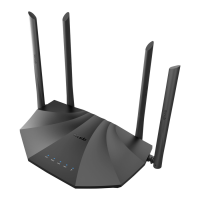
Do you have a question about the Tenda AC19 and is the answer not in the manual?
| DSL WAN | No |
|---|---|
| Ethernet WAN | Yes |
| Wi-Fi band | Dual-band (2.4 GHz / 5 GHz) |
| Wi-Fi standards | 802.11b, 802.11g, Wi-Fi 4 (802.11n) |
| Top Wi-Fi standard | Wi-Fi 4 (802.11n) |
| WLAN data transfer rate (max) | - Mbit/s |
| Cabling technology | 10/100/1000Base-T(X) |
| Networking standards | IEEE 802.3, IEEE 802.3ab, IEEE 802.3u |
| Ethernet LAN data rates | 10, 100, 1000 Mbit/s |
| Ethernet LAN interface type | Gigabit Ethernet |
| Ethernet LAN (RJ-45) ports | 4 |
| USB 3.2 Gen 1 (3.1 Gen 1) Type-A ports quantity | 1 |
| Security algorithms | WPA-PSK, WPA2, WPS |
| Product type | Tabletop router |
| Product color | Black |
| LED indicators | LAN, Power, System, USB, WPS |
| Antenna gain level (max) | 6 dBi |
| Certification | CE, FCC, RoHS |
| Output current | 2 A |
| Output voltage | 12 V |
| AC input voltage | 100 - 240 V |
| Power source type | AC |
| AC input frequency | 50 - 60 Hz |
| Storage temperature (T-T) | -40 - 70 °C |
| Operating temperature (T-T) | 0 - 40 °C |
| Storage relative humidity (H-H) | 5 - 90 % |
| Operating relative humidity (H-H) | 10 - 90 % |
| Cables included | LAN (RJ-45) |
| Harmonized System (HS) code | 85176990 |
| Depth | 238.9 mm |
|---|---|
| Width | 144.3 mm |
| Height | 403 mm |
Details the AC2100 dual band gigabit WiFi router's features and capabilities.
Explains the status and meaning of each LED indicator on the router.
Describes the function of each port and button on the router.
Information provided on the router's bottom label, including IP address and MAC.
Step-by-step guide to access and log into the router's web interface.
Describes the structure and components of the router's web user interface.
How to check and understand the router's current internet connection status.
View and configure parameters related to the router's WiFi network.
View details of devices connected to the router and manage access.
Block specific devices from accessing the internet through the router.
Configure the router to connect to the internet using PPPoE credentials.
Configure the router for internet access using a dynamic IP address.
Configure the router for internet access using static IP address details.
Overview of settings for changing the WiFi network name and password.
Configure distinct WiFi names for the 2.4 GHz and 5 GHz bands.
Procedure for updating the WiFi network name and security password.
Steps to make the WiFi network invisible to nearby devices for enhanced security.
Function to schedule when WiFi networks are enabled or disabled.
Extend WiFi coverage by using the router as a repeater.
Adjusts wireless channel and bandwidth for 2.4/5GHz networks.
Functionality for connecting devices using Wi-Fi Protected Setup.
Configure the router to function as an Access Point.
Functionality for creating a separate guest WiFi network.
Step-by-step guide to set up a guest network with bandwidth limits.
View and configure internet access options for online devices.
How to set up rules for device internet access based on time and websites.
Functionality to set up a PPTP VPN server for secure remote access.
Functionality to connect the router to PPTP/L2TP VPN servers.
How to configure the router to access ISP's VPN resources.
Functionality for USB storage devices (AC19 only).
Accessing files on a USB drive connected to the router from within the local network.
Accessing files on a USB drive from outside the local network.
Configuring the router's connection to the IPv6 network.
Overview and configuration for accessing the internet using PPPoEv6.
Overview and configuration for accessing the internet with a static IPv6 address.
Explains IPv6 transition mechanisms like dual stack and tunneling.
Function to limit upload/download speeds of devices for fair bandwidth allocation.
Configuration for IPTV services, including multicast and STB setup.
Managing the router via the Tenda WiFi mobile application.
Function to allow or block devices based on their MAC addresses.
Defends against ICMP, TCP, UDP flood attacks and ignores ping packets.
Manually configuring optimal data transfer paths for network routing.
Dynamic DNS function for accessing internal servers with a fixed domain name.
Opens router ports to allow external access to specific LAN services.
Disables firewall restrictions for specific hosts to improve internet communication.
Configuring LAN IP address, subnet mask, and DHCP server parameters.
Settings related to the WAN connection, including MTU, speed, and MAC address.
Cloning or setting a custom MAC address for the WAN port, often for ISP binding.
Configuring the router's system time, either by syncing with the internet or manual entry.
Setting and changing the router's web UI login password for security.
Procedures for rebooting the router or restoring it to factory default settings.
Updating the router's firmware for new features and stability.
Backing up and restoring router configurations to prevent data loss.
Enabling remote access to the router's web UI for management and support.
Displays overview of router status including basic info, WAN, LAN, WiFi, and IPv6.
Schedules regular router restarts for improved stability and longevity.
Steps for automatically obtaining IPv4 address in Windows 10, 8, and 7.
Lists default IP, LAN, DHCP, and wireless settings for router models.
Glossary of technical terms and abbreviations used in the manual.